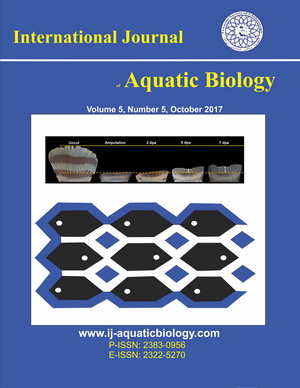Diet composition and feeding habits of the milk shark Rhizoprionodon acutus (Rüppell, 1837) in the Gulf of Suez, Red Sea
Downloads
This study is aimed to provide detailed information on the diet of Rhizoprionodon acutus in the Gulf of Suez. The findings suggest the specialized feeding behavior of this species in the Gulf of Suez. A total of 240 Stomachs of R. acutus were examined. The number of stomachs that contained prey items was 146 (60.83%), while 94 stomachs were empty (39.16%). Identifiable prey items belonging to 24 species of marine organisms correspond to 13 families of teleost fishes, three families of cephalopods, two families of crustaceans, one of eels, and one of sea urchins. Prey items of little importance included the teleost fishes Lutjanus bohar (0.003% (and the sea urchin Clypeaster humilis, (0.004%); each was only found in one stomach. Unidentified teleosts comprised the bulk of the observed prey items in terms of frequency of occurrence (63.7%), number (66.67%), weight (53.94%), and relative importance (96.54%). The identified prey items contained pelagic, demersal, reef-associated, and benthic organisms. When grouping food items into their large categories and comparing them in terms of %IRI, teleost fishes were the preferable prey item, with 96.54% unidentified and 1.49% identified, followed by Cephalopods (1.73%), eels (0.16%) and finally, Crustacean (0.09%). The trophic level of R. acutus in the Gulf of Suez was estimated to be 4.2, which categorizes it as a tertiary consumer.
Downloads
Ahmed A.M.M., Azab M., Khalaf-Allah H.M.M., El-Tabakh M.A. (2022). Observations on food and feeding habits of the common smooth hound shark, Mustelus mustelus in the Mediterranean Sea at Alexandria coast, Egypt. Egyptian Journal of Aquatic Biology and Fisheries, 26(3): 123-138.
Amundsen P.A., Gabler H.M., Staldvik F.J. (1996). A new approach to graphical analysis of feeding strategy from stomach contents data – modification of Costello (1990) method. Journal of Fish Biology, 48: 607-614.
Ba A., Diop M.S., Diatta Y., Dossa J., Ba C.T. (2013). Diet of the milk shark, Rhizoprionodon acutus (Chondrichthyes: Carcharhinidae), from the Senegalese coast. Journal of Applied Ichthyology, 1: 1-7.
Bethea D.M., Buckel J.A., Carlson J.K. (2004). Foraging ecology of the early life stages of four sympatric shark species. Marine Ecology Progress Series, 269: 245-264.
Bethea D., Hale L., Carlson J., Cortés E., Manire C., Gelsleichter J. (2007). Geographic and ontogenetic variation in the diet and daily ration of the bonnethead shark, Sphyrna tiburo, from the eastern Gulf of Mexico. Marine Biology, 152(5): 1009-1020.
Bonfil R., Abdallah M. (2004). Field identification guide to the sharks and rays of the Red Sea and Gulf of Aden. Food and Agriculture Org.
Bornatowski H., Heithaus M.R., Abilhoa V., Corrêa M.F.M. (2012). Feeding of the Brazilian sharpnose shark Rhizoprionodon lalandii (Müller & Henle, 1839) from southern Brazil. Journal of Applied Ichthyology, 28(4): 623-627.
Borrell A., Cardona L., Kumarran R.P., Aguilar A. (2011). Trophic ecology of elasmobranchs caught off Gujarat, India, as inferred from stable isotopes. – ICES Journal of Marine Science, 68: 547-554.
Braccini M.J. (2008). Feeding ecology of two high-order predators from southeastern Australia: the coastal broadnose and the deep-water sharp nose seven gill sharks. Marine Ecology Progress Series, 371: 273-284.
Compagno L.J.V. (1984). FAO species Catalogue. Vol. 4 Sharks of the World. Anannotated and illustrated catalogue of shark species known to date. Part 2. Carcharhiniformes. FAO Fish. Synop., (125) Vol. 4, Part 2: 251-655
Compagno L.J.V. (2001). Sharks of the world: An annotated and illustrated catalogue of shark species known to date, Vol.2. Bullhead, mackerel and carpet sharks (Heterodontiformes, Lamniformes and Orectolobiformes): FAO Species catalogue for
fishery purposes No. 1, Vol. 2, Roma.
Compagno L.J.V., Dando M., Fowler S. (2005). Sharks of the world. 368 p.
Cortés E. (1997). A critical review of methods of studying fish feeding based on analysis of stomach contents: application to elasmobranch fishes. Canadian Journal of Fisheries and Aquatic Sciences, 54: 726-738.
Cortés E. (1999). Standardized diet compositions and trophic levels of sharks. ICES Journal of Marine Science, 56: 707-717.
Costa S., Neves J., Tirá G., Andrade J.P. (2023). Predatory responses and feeding behaviour of three elasmobranch species in an aquarium setting. Journal of Zoological and Botanical Gardens, 4: 775-787.
Drymon J.M., Powers S.P., Carmichael R.H. (2011). Trophic plasticity in the Atlantic sharpnose shark (Rhizoprionodon terraenovae) from the north central Gulf of Mexico. Environmental Biology of Fishes, 95: 21-35
Ellis J.K. (2003). Diet of the sandbar shark, Carcharhinus plumbeus, in Chesapeake Bay and adjacent waters. (Master of Science), The College of William and Mary, Virginia.
Ellis J.K., Musick J.A. (2007). Ontogenetic changes in the diet of the sandbar shark, Carcharhinus plumbeus, in lower Chesapeake Bay and Virginia (USA) coastal waters. Environmental Biology of Fishes, 80: 51-67.
Fischer W., Bianchi G. (1984). FAO Species Identification Sheets for Fishery Purposes.Western Indian Ocean (Fishing Area 51), Rome, vols. 1-6.
Gelsleichter J., Musick J.A., Nichols S. (1999). Food habits of the smooth dogfish, Mustelus canis, dusky shark, Carcharhinus obscurus, Atlantic sharpnose shark, Rhizoprionodon terraenovae, and the sand tiger, Carcharias taurus, from the northwest Atlantic Ocean. Environmental Biology of Fishes, 54: 205-217.
Gómez F.E., Bashirulah A.K.M. (1984). Relación longitud–pesoy hábitos alimenticios de Rhizoprionodon porosus, Poey 1861 (Fam. Carcharhinidae) en el Oriente de Venezuela. Boletín del Instituto Oceanográfico de Venezuela, 23(1 and 2): 49-54.
Gutteridge A.N., Bennett M.B., Huveneers C., Tibbetts I.R. (2011). Assessing the overlap between the diet of a coastal shark and the surrounding prey communities in a sub?tropical embayment. Journal of Fish Biology, 78(5): 1405-1422.
Harry A.V., Tobin A. J., Simpfendorfer C.A., Welch D.J., Mapleston A., White J., Williams A.J., Stapley J. (2011). Evaluating catch and mitigating risk in a multi-species, tropical, inshore shark fishery within the Great Barrier Reef World Heritage Area. Marine and Freshwater Research, 62: 710-721.
Heithaus M.R., Frid A., Vaudo J.J., Worm B., Wirsing A.J. (2010). Unraveling the ecological importance of elasmobranchs. In: Sharks and their relatives II: biodiversity, adaptive physiology and conservation. Carrier, J. C., Musick, J.A. and eithaus, M.R. (Eds). CRC Press, Boca Raton, FL. pp: 611-637.
Henderson A C., McIlwain J.L., Al-Oufi H.S., Al-Seili S. (2007). The Sultanate of Oman shark fishery: species composition, seasonality and diversity. Fisheries Research, 86: 159-168.
Hoffmayer E.R., Parsons G.R. (2003). Food habits of three shark species from the Mississippi sound in the northern Gulf of Mexico. Southeastern Naturalist, 2: 271-280.
Huveneers C., Otway N.M., Gibbs S.E., Harcourt R.G. (2007). Quantitative diet assessment of wobbegong sharks (genus Orectolobus) in New South Wales, Australia. ICES Journal of Marine Science, 64: 1272–1281.
Hyslop E.J. (1980). Stomach contents analysis—a review of methods and their application. Journal of Fish Biology, 17(4): 411-42
Jabado R.W., Al Ghais S.M., Hamza W., Henderson A.C., Al Mesafri A.A. (2015). Diet of two commercially important shark species in the United Arab Emirates: milk shark, Rhizoprionodon acutus (Rüppell, 1837), and slit?eye shark, Oxodon macrorhinus (Müller & Henle, 1839). Journal of Applied Ichthyology, 31(5): 870-875
Joyce W.N., Campana S.E., Natanson L.J., Kohler N.E., Pratt Jr H.L., Jensen C.F. (2002). Analysis of stomach contents of the porbeagle shark (Lamna nasus Bonnaterre) in the northwest Atlantic. ICES Journal of Marine Science, 59: 1263-1269.
Kara A.F., Al Hajaji M., Ghmati H., Shakman E.A. (2019). Food and feeding habits of Mustelus mustelus (Linnaeus, 1758) (Chondrichthyes: Triakidae) along the Western coast of Libya. Annales Series Historia Naturalis, 29(2): 197-204.
Last P.R., Stevens J.D. (2009). Sharks and rays of Australia, CSIRO, Hobart, Australia. Melbourne. 656 p.
Lowe C.G., Wetherbee B.M., Crow G.L., Tester A.L. (1996). Ontogenetic dietary shifts and feeding behavior of the tiger shark, Galeocerdo cuvier, in Hawaiian waters. Environmental Biology of Fishes, 47: 203-211.
Márquez–Farias J.F., Corro-Espinosa D., Castillo-Geniz J.L. (2005). Observations on the biology of the Pacific sharpnose shark (Rhizoprionodon longurio, Jordan and Gilbert, 1882), captured in Southern Sinaloa, Mexico. Journal of Northwest Atlantic Fishery Science, 35: 107-114.
McElroy D.W., Wetherbee B.M., Mostello C.C., Lowe C.G., Crow G.L., Wass R.C. (2006). Food habits and ontogenetic changes in the diet of the sandbar shark, Carcharhinus plumbeus, in Hawaii. Environmental Biology of Fishes, 76: 81-92.
Nakamura I., Watanabe Y.Y., Papastamatiou Y.P., Sato K., Meyer C.G. (2011). Yo-yo vertical movements suggest a foraging strategy for tiger sharks Galeocerdo cuvier. Marine Ecology Progress Series, 424: 237-246.
Özcan E.I., Basusta N.I. (2016). Digestive system contents of the Mustelus mustelus (Linnaeus, 1758) inhabiting northeastern Mediterranean. Journal of Science, 28(1): 7-12.
Pauly D., Palomares M.L. (2000). Approaches for Dealing with Three Sources of Bias when Studying the Fishing Down Marine Food Web Phenomenon. In: F. Briand (Ed.), Fishing Down the Mediterranean Food Webs? Vol. 12, CIESM Workshop Series. pp: 61-66.
Pauly D., Trites A., Capuli E., Christensen V. (1998). Diet composition and trophic levels of marine mammals. ICES Journal of Marine Science, 55(3): 467-481.
Pinkas L.M., Oliphant S., Iverson L.K. (1971). Food habits of albacore, bluefin tuna, and bonito in Californian waters. California Fish and Game, 152: 1-105.
Preti A., Smith S.E., Ramon D.A. (2004). Diet differences in the thresher shark (Alopias vulpinus) during transition from a warm water regime to a cool-water regime off California–Oregon, 1998– 2000. Reports of California Cooperative Oceanic Fisheries Investigations, 45: 118-125.
Randall J.E. (1983). Red Sea reef fishes. IMMEL Press, London. 192 p.
Rastgoo A.R., Navarro J. (2017). Trophic levels of teleost and elasmobranch species in the Persian Gulf and Oman Sea. Journal of Applied Ichthyology, 33(3): 403-408.
Saïdi B., Enajjae S., Bradai M.N., Bouain A. (2009). Diet composition of smooth-hound shark, Mustelus mustelus (Linnaeus, 1758), in the Gulf of Gabes, southern Tunisia. Journal of Applied Ichthyology, 25: 113-118.
Salini J.P., Blaber S.J.M., Brewer D.T. (1990). Diets of piscivorous fishes in a tropical Australian estuary, with special reference to predation on penaeid prawns. Marine Biology, 105: 363-374.
Salini J.P., Blaber S.J.M., Brewer D.T. (1992). Diets of sharks from estuaries and adjacent waters of the North-eastern Gulf of Carpentaria, Australia. Marine and Freshwater Research, 43(1): 87-96.
Shiffman D.S., Frazier B.S., Kucklick J.R., Abel D., Brandes J., Sancho (2014). Feeding ecology of the sandbar shark in South Carolina Estuaries revealed through 13c and 15n stable isotope analysis. Marine and Coastal Fisheries: Dynamics, Management, and Ecosystem Science, 6: 156-169.
Silva C.M.L., Almeida Z.S. (2001). Alimentacao de Rhizoprionodon porosus (Elasmobranchii: Carcharhinidae) da costa do Maranhao, Brasil. Boletim do Instituto de Pesca, 27: 201-207.
Simpfendorfer C.A. (1992). Biology of tiger sharks (Galeocerdo cuvier) caught by the Queensland shark meshing program off Townsville, Australia. Australian Journal of Marine and Freshwater Research, 43: 33-43.
Simpfendorfer C.A. (1998). Diet of the Australian sharpnose shark, Rhizoprionodon taylori, from northern Queensland. Marine and Freshwater Research, 49: 757-761.
Simpfendorfer C.A., Goodreid A.B., McAuley R.B. (2001). Size, sex and geographic variation in the diet of the tiger shark Galeocerdo cuvier, from Western Australian waters. Environmental Biology of Fishes, 61: 37-46.
Sims D.W., Southall E.J., Humphries N.E., Hays G.C., Bradshaw C.J.A., Pitchford J.W., James A., Ahmed M.Z., Brierley A.S., Hindell M.A., Morritt D., Musyl M. K., Righton D., Shepard E.L.C., Wearmouth V.J., Wilson R.P., Witt M.J., Metcalfe J.D. (2008). Scaling laws of marine predator search behaviour. Nature, 451: 1098-1102.
Stevens J.D., McLoughlin K.J. (1991). Distribution, size and sex composition, reproductive biology and diet of sharks from northern Australia. Australian Journal of Marine and Freshwater Research, 42: 151-199.
Wetherbee B.M., Cortés E. (2004). Food consumption and feeding habits. In: J.F. Carrier, J.A. Musik, M. Heithaus (Eds.). Biology of sharks and their relatives, CRC press. USA.
White W.T. (2007). Catch composition and reproductive biology of whaler sharks (Carcharhiniformes: Carcharhinidae) caught by fisheries in Indonesia. Journal of Fish Biology, 71: 1512-1540.
Copyright (c) 2024 International Journal of Aquatic Biology

This work is licensed under a Creative Commons Attribution 4.0 International License.








